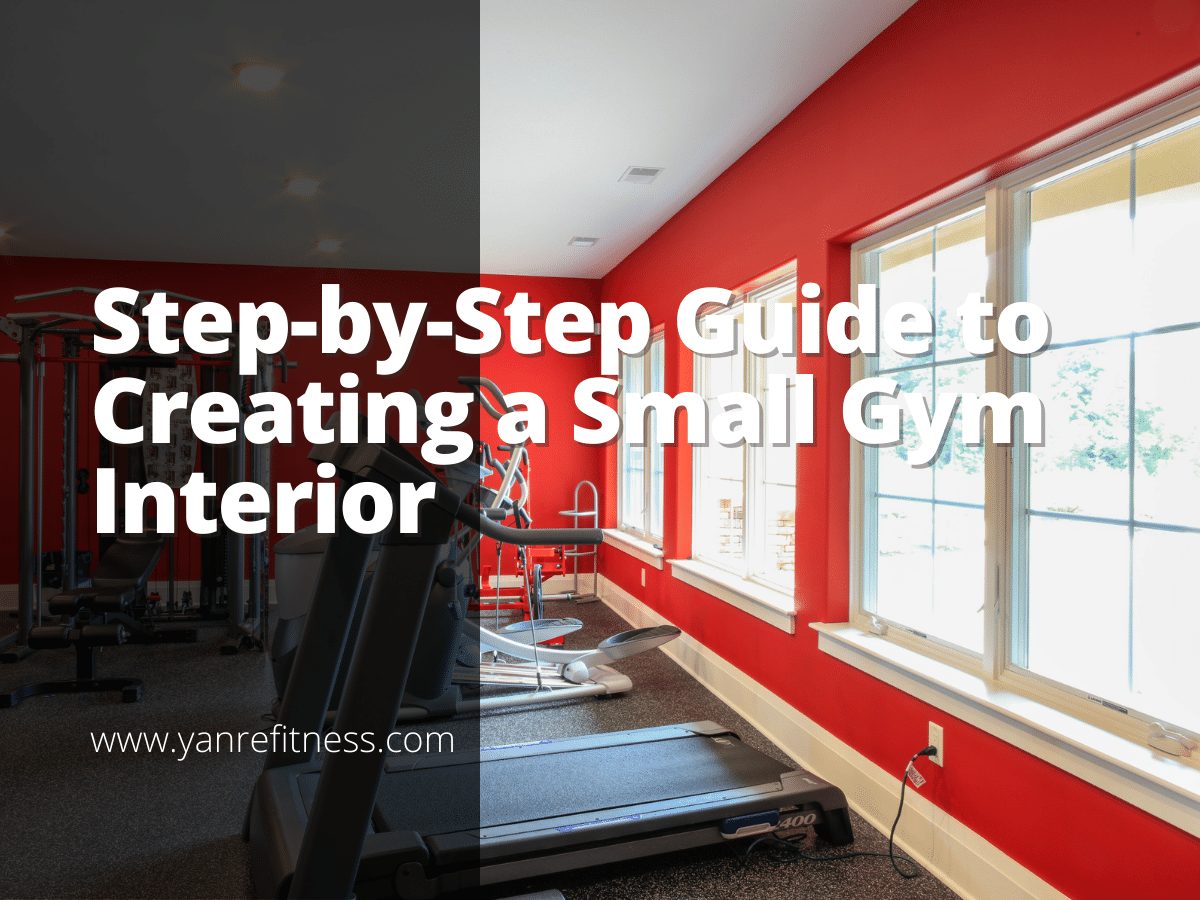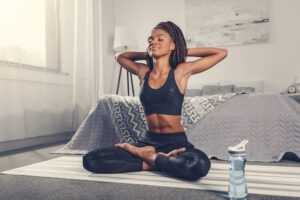Ever asked yourself, “How can I make the most out of my small gym space?” Maximizing a small gym’s interior is more than just a space challenge. The struggle lies in effectively utilizing the limited space, selecting the right equipment, ensuring safety, and enhancing aesthetics, all while maintaining a high level of comfort.
But don’t worry, this comprehensive guide promises a step-by-step approach to transform a small gym into an optimized fitness hub. It’s time to turn those small corners into robust workout spaces. So, let’s discover how to unlock the full potential of a small gym interior.
Read on to discover the secrets of designing the best commercial gym layout ideas.
Table of Contents
Step#1 Evaluating the Size and Shape of Your Gym
An essential initial step in setting up a small gym business is a careful evaluation of its size and shape, addressing questions like, “How do I start a small gym business?” and “What is the minimum cost to open a gym?” This assessment provides valuable information that guides the gym’s layout, equipment selection, and overall design. Below are 5 strategies to help conduct an effective evaluation:
Comprehensive Measurement
This includes not just the floor area, but also the height of the ceiling, the dimensions of any existing features like pillars or platforms, and the size of entryways. According to Vevano, having accurate measurements increases efficiency throughout the whole process, whether the project is DIY or you choose to work with a designer.
Anytime Fitness gyms, for example, where the precise use of space allows them to set up functional facilities even in compact locations. As a gym owner, it has been observed that precise measurements form the basis of every successful gym layout.
Space Analysis
Space analysis is the process of understanding how the area can best be utilized. This involves identifying potential zones for different activities, such as weightlifting, cardio, stretching, or even ancillary spaces like locker rooms or reception areas. Based on personal experiences, careful space analysis has consistently proven to be instrumental in making the most of the available gym area.
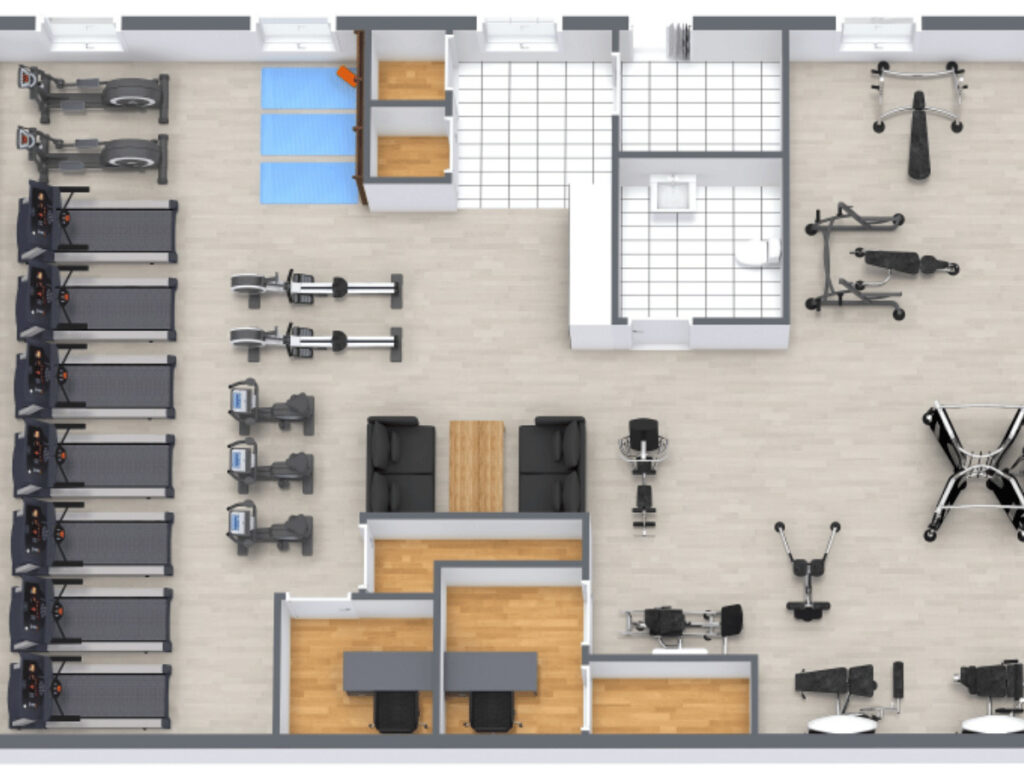
Structural Assessments
A structural assessment looks at the gym’s existing features, like load-bearing walls, pillars, or low ceilings, that could affect the layout or placement of equipment. This step can help identify any potential obstacles to creating an optimal gym layout. Structural assessments have been key in avoiding unforeseen issues during the setup process.
Door and Window Placement
Taking into account the placement of doors and windows is essential when evaluating the gym’s shape and size. These features impact natural light, ventilation, and the possible arrangement of gym equipment and zones. It has been found that considering door and window placements early in the planning process saves from design adjustments later on.
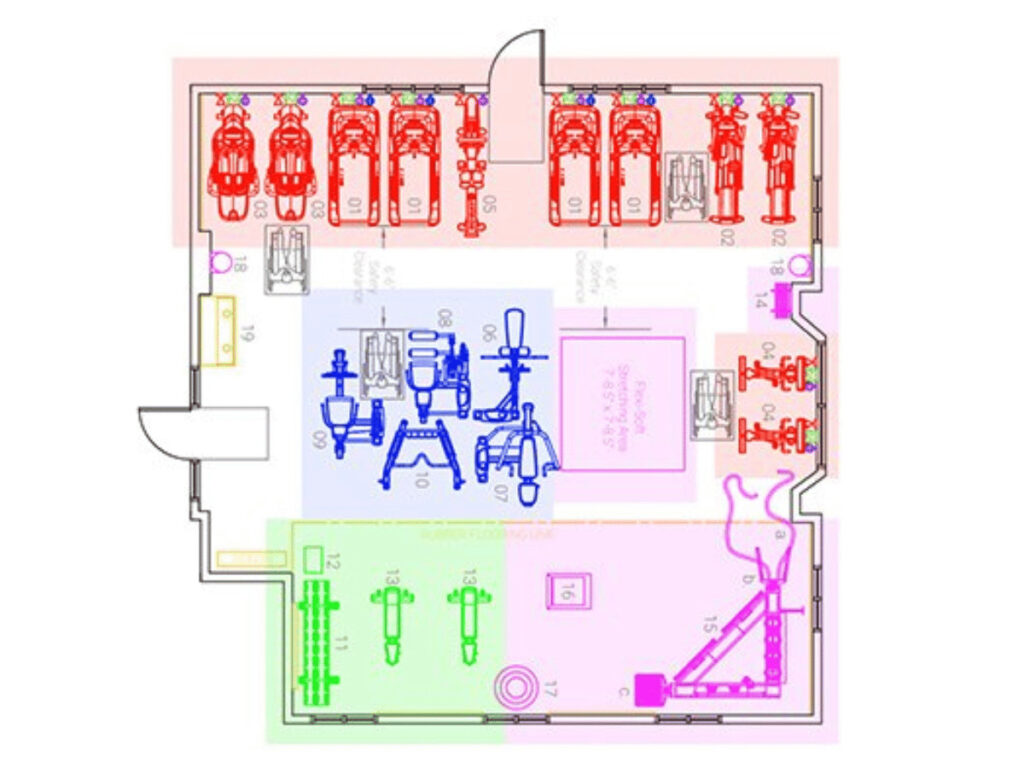
Future Expansion Potential
While the current size and shape of the gym are the immediate focus, it’s also useful to consider the potential for future expansion. This could involve knocking down a wall, extending upwards, or even the possibility of acquiring adjacent space. Having personally seen how gyms evolve over time, considering future expansion potential in the initial evaluation stages is a worthwhile investment.
Step#2 Creating a Functional Layout
Formulating a functional layout is a critical step in designing a small gym interior, addressing aspects like small commercial gym ideas, including factors like What is the minimum size for a commercial gym? It involves assessing space availability, strategizing equipment placement, and determining appropriate zoning for various activities. To help in this process, the following strategies should be considered:
Space Allocation
The foremost consideration in a gym layout is how to allocate space most effectively. It’s crucial to ensure there’s enough room for all the equipment and to accommodate users comfortably. The ideal space allocation allows for unobstructed movement and efficient utilization of each square foot. A small gym with space constraints should, therefore, focus on essential pieces of equipment that provide maximum workout versatility.
Safety Measures
Besides efficient space utilization, ensuring gym-goer safety is an important aspect of a functional gym layout. Placement of machines and equipment should facilitate clear walkways to minimize accidents. Also, areas where intense activities take place should be distant from quiet zones to avoid unnecessary conflicts.
Being an owner of a small gym myself, I have witnessed the positive impact of prioritizing safety in gym layout design. It not only safeguards users but also significantly enhances their workout experience.
Integrating Functional Zones
Zoning involves creating designated areas for different activities; examples are cardio, strength training, stretching, or relaxation. This strategy contributes to creating a systematic flow of movement, reduces congestion, and maximizes equipment usage. The notion of zoning proved highly beneficial in my own gym. It has not only helped in streamlining the layout but also improved the overall client experience.
Focusing on Aesthetics
Aesthetics, while not directly impacting the functionality, significantly contributes to the overall ambiance and user experience. The color palette, lighting, artwork, or even the arrangement of equipment can influence how inviting and energizing a gym feels. It indicates that well-thought-out aesthetics can potentially boost user motivation and satisfaction.
Step#3 Gym Equipment Selection
Choosing the right equipment is another critical aspect of creating an inviting small gym interior. Selection depends on space availability, the gym’s targeted clientele, and budget constraints. This section delves into the strategies of effective equipment selection, prioritizing versatile equipment, considering user preferences, and incorporating technological innovations.
Effective Equipment Selection
According to Statista, Health & Fitness market is projected to have an annual growth rate (CAGR 2022-2027) of 8.71% by 2027, indicating the constant development of better, space-optimized machines. The key to effective equipment selection lies in striking a balance between providing a comprehensive workout experience and optimizing the available space.
Smaller gym spaces require careful consideration to avoid overcrowding and ensure safety. Having personally navigated this aspect, a well-thought-out selection process ensures that the gym caters to diverse workout needs within a confined space.
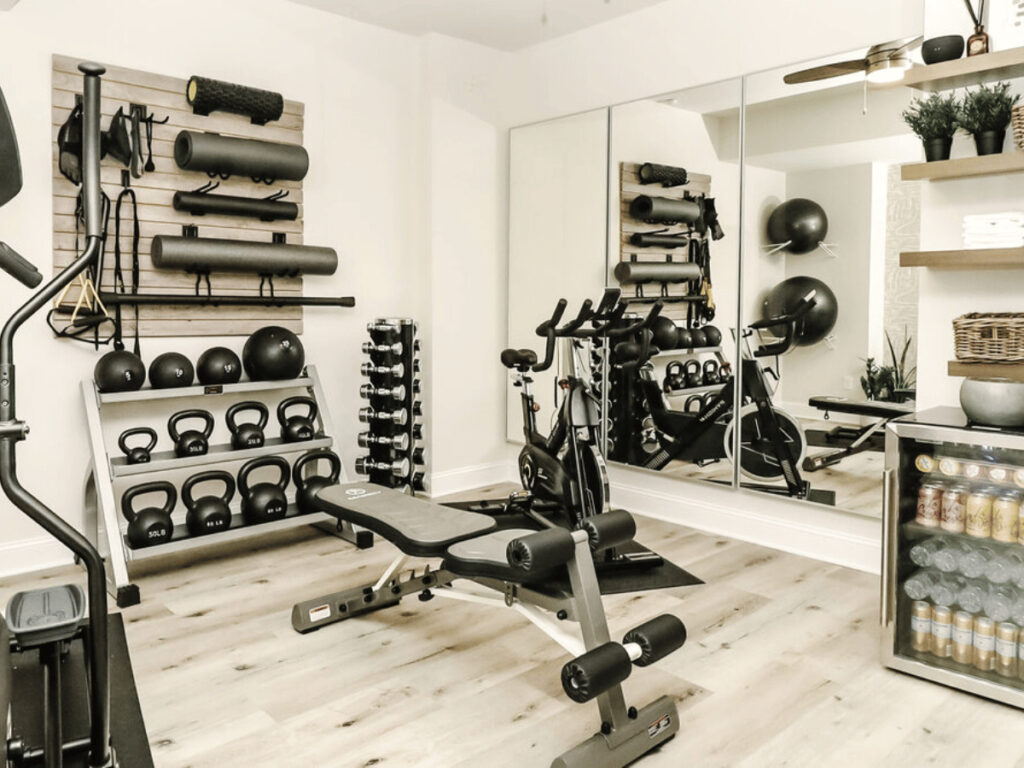
Versatile Equipment
For small gyms, versatile, multi-functional equipment is a game-changer. Machines like adjustable dumbbells, suspension trainers, or multi-gyms can provide a full-body workout while minimizing the space requirement. In managing a small gym, it has been evident that investing in versatile equipment enhances the gym’s usability without causing spatial constraints.
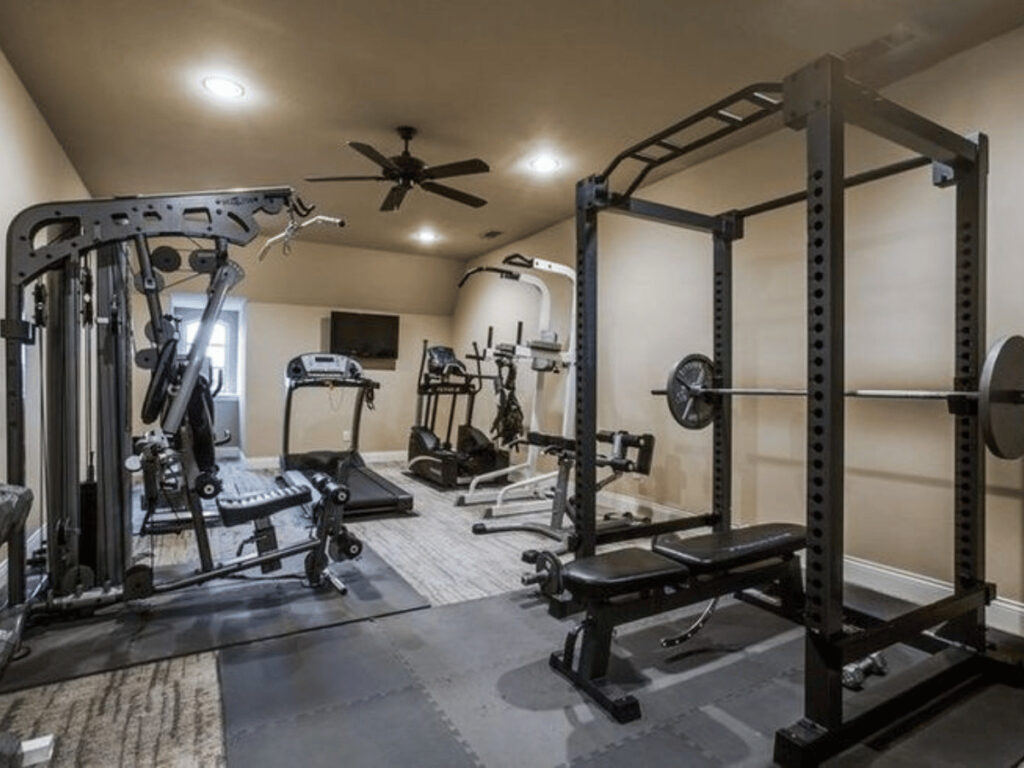
User Preferences
When selecting equipment, it’s essential to understand the workout preferences of the target clientele. Some gym-goers may prefer cardio, others strength training, while some enjoy a mix of both. Yanre Fitness offers a broad range of gym equipment catering to various workout preferences, assisting in curating a diverse and enjoyable fitness environment.
Technological Innovations
With advancements in technology, modern gym equipment can offer exciting features like interactive workout sessions, progress tracking, and personalized training programs. Including these can enhance user experience and give a small gym a competitive edge. Yanre Fitness consistently incorporates technological innovations into their equipment lineup, ensuring gym-goers have access to the latest fitness advancements.
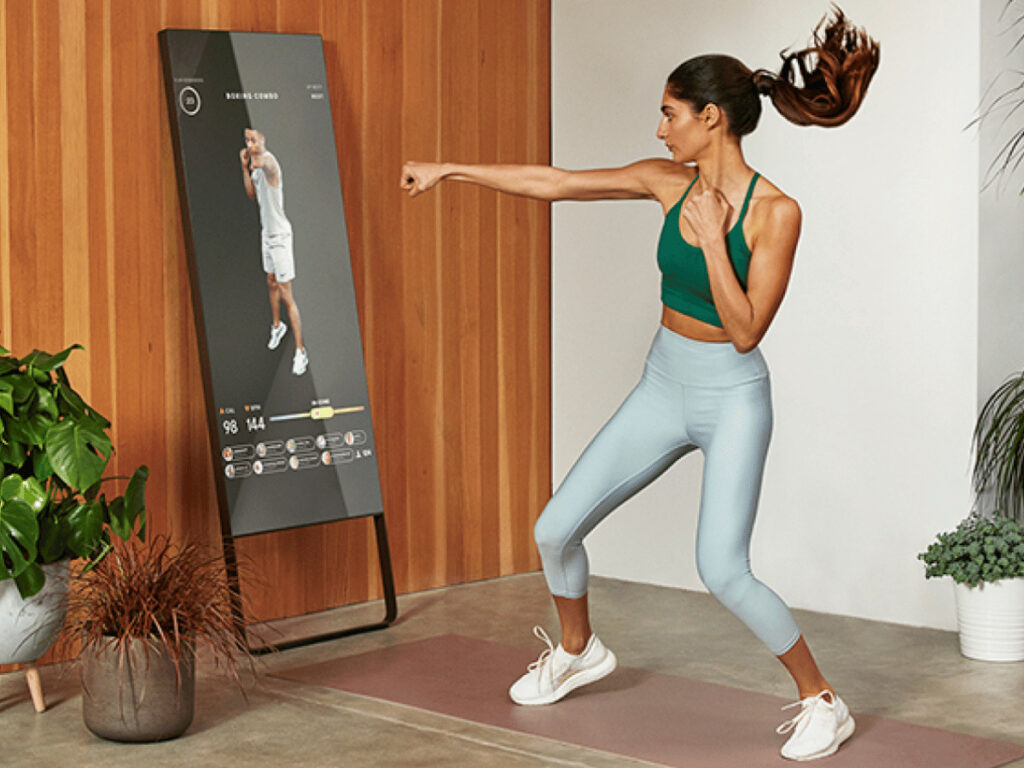
Step#4 Aesthetics and Ambience
Creating an inviting gym atmosphere goes beyond equipment and layout. The choice of color, lighting, and decorative elements significantly contribute to the gym’s ambiance. In this section, the focus will be on the role of color in gym design, lighting design for workout spaces, and art, murals, and inspirational wall decals.
Color in Gym Design
Color plays an influential role in setting the mood of a gym. Bright, bold colors may induce energy and motivation, while cool, calming colors may create a serene environment conducive to focus and concentration. Having experimented with different color schemes in the gym, it’s evident that the right color choice significantly enhances the workout environment.
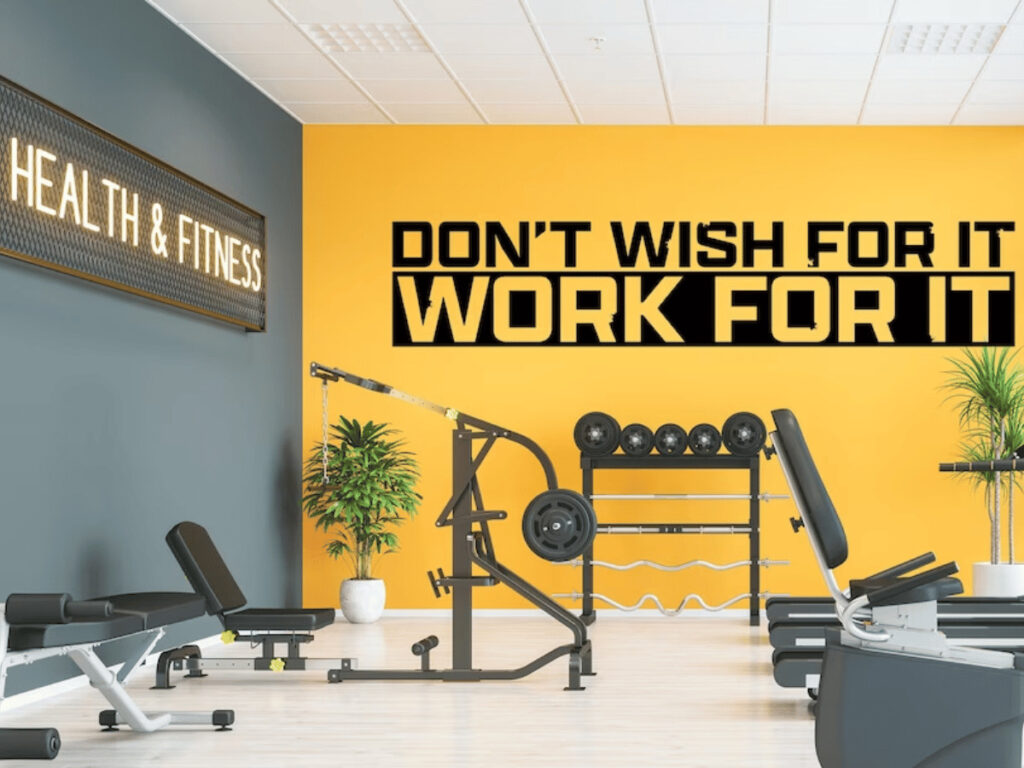
Lighting Design
Lighting design is another factor that dramatically affects a gym’s atmosphere. Adequate lighting not only aids in functional aspects like safety but can also influence the gym-goer’s mood and motivation. From personal experience, investing in quality lighting design resulted in a visibly positive shift in the gym’s atmosphere and member satisfaction. Here are some useful lighting designs for the gym:
- Ambient lighting: This is the base layer of lighting that provides general illumination in the gym. It ensures safety and visibility, creating a bright and welcoming environment conducive to workouts.
- Task lighting: Task lighting focuses on specific areas or equipment to aid in performing particular activities, such as spotlighting treadmills or weightlifting areas. This type of lighting helps to prevent accidents and enhance concentration during workouts.
- Mood lighting: Mood lighting, often adjustable or color-changing, can create an inspiring or energizing atmosphere in workout spaces. For instance, cooler colors can provide a calming effect for yoga rooms, while warm, vibrant lights can boost energy in cardio zones.
Art, Murals and Inspirational Wall Decals
Incorporating art, murals, or inspirational wall decals can add a touch of personality to a gym. They can serve as motivational boosts and improve the overall aesthetics of the space. Adding art and motivational decals in the gym, based on personal observation, not only improved the look and feel of the space but also played a role in uplifting the gym-goers’ spirits.
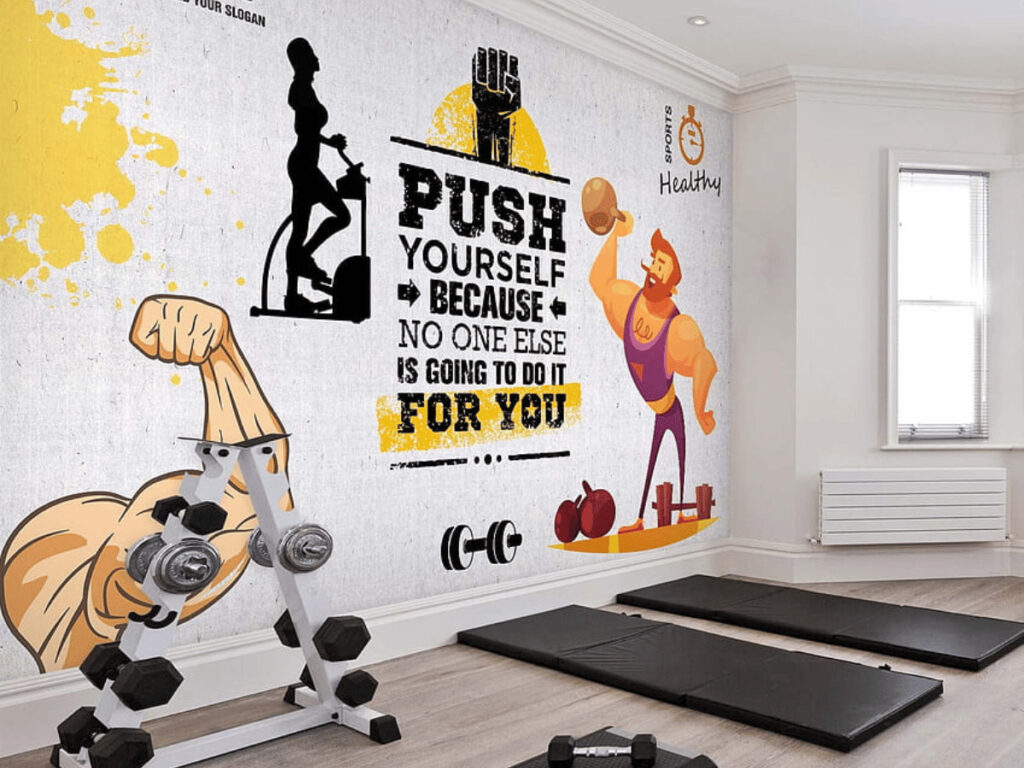
Step#5 Safety and Comfort
Ensuring safety and comfort in a gym is a multifaceted process. This involves everything from the selection and layout of equipment to the overall environment. To address this, focus on the details below:
Equipment Safety Measures
Safety measures around gym equipment include regular maintenance, proper instruction on equipment use, and ensuring enough space between machines. A significant portion of gym-related injuries can be attributed to improper use or malfunctioning of equipment. Emphasizing equipment safety not only keeps the gym environment safer but also increases the confidence of gym-goers.
Injury Prevention Strategies
Gym layouts and rules should be designed with injury prevention in mind. This includes clear walkways, non-slip floors, and adequate signage indicating potential hazards. Gyms that implement injury prevention strategies effectively reduce accident rates. It has been evident that the implementation of injury prevention strategies significantly reduces accidents and improves the overall safety profile of the gym.
Gym Hygiene
Maintaining high hygiene standards is essential for a safe and comfortable gym environment. This involves regular cleaning of equipment, provision of sanitizers, and ensuring well-maintained washroom facilities. Maintaining a clean and hygienic gym environment, from personal experience, not only reassures gym-goers but also contributes significantly to their comfort and satisfaction.

Comfortable Workout Environment
Creating a comfortable workout environment involves factors such as room temperature, ventilation, and noise control. These elements contribute to the overall workout experience and can impact gym-goer satisfaction. The comfort level of the gym environment significantly influences workout performance. As I enhance the comfort factors in my gym it has directly improved workout experiences and boosted member retention.
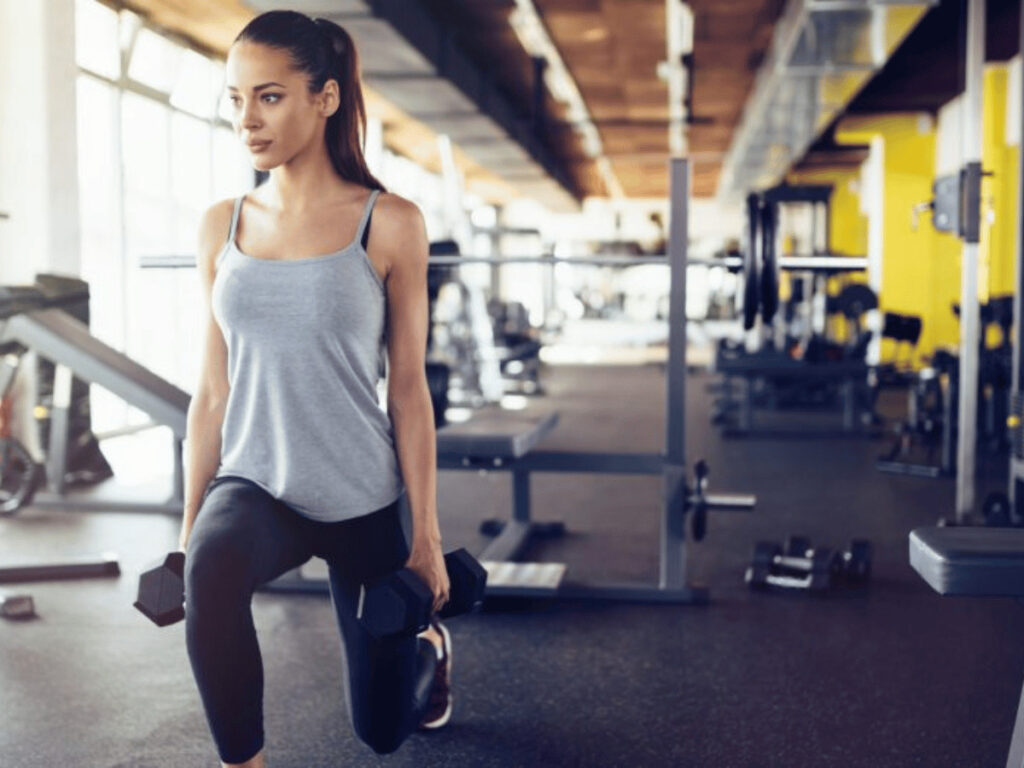
Emergency Preparedness
Being prepared for emergencies, such as injuries, sudden illnesses, or fires, is a key aspect of gym safety. This involves having first-aid kits accessible, staff trained in basic first-aid, and clear emergency exit routes. In running a gym, it’s become clear that effective emergency preparedness gives gym-goers peace of mind and fosters a safer workout environment.
Step#6 Smart Storage Solutions
A well-organized gym not only looks more inviting but also promotes safety and efficiency. Effective storage solutions help maintain order, keep the gym clutter-free, and optimize available space. In this step, the well discussed the strattegies in making a smart storage solutions which are:
Utilizing Vertical Space
Vertical storage solutions are an excellent way to optimize space in a small gym. This includes wall-mounted racks for weights, hanging solutions for mats, or even shelving for towels and gym accessories. As an expert in this industry, utilizing vertical space has significantly improved the gym’s organization and spatial efficiency for those opening a gym.
Modular Storage
Modular storage units can be rearranged as needed, providing flexibility in storage solutions. These can be especially beneficial for gyms offering a variety of workout options. Integrating a modular storage will surely helped maintain a versatile and adaptable gym layout and space.
Multifunctional Furniture
When considering the question, “What equipment do you need for a small gym?” it’s essential to think creatively about space utilization. Multifunctional furniture, such as benches with built-in storage or stackable stools, can serve multiple purposes and save space. These versatile pieces can be used for seating, storage, or even as workout props. Using multifunctional furniture has proven effective in personal practice and small gym setups, enhancing functionality without compromising on space.
Custom-Built Storage
Custom-built storage allows for tailored solutions that cater to the specific needs and constraints of a small gym. This could involve built-in wall storage, under-stair storage, or customized lockers. From personal observation, custom-built storage solutions have drastically improved the efficiency of space usage in the gym, offering tailored storage for specific needs.
De-Cluttering
Regular de-cluttering is essential to maintain a tidy, organized gym, especially when considering a small gym floor plan. This involves periodic audits of equipment, supplies, and storage areas to remove unused or unnecessary items. Regular de-cluttering in the gym has shown to significantly improve the workout environment and the efficiency of space usage for an improved gym ambiance.
This table provides an overview of strategies for smart storage solutions in a gym, along with their descriptions and the benefits they offer, to enhance organization, optimize space, and improve efficiency.
| Strategy | Description | Benefits |
| Utilizing Vertical Space | Utilize wall-mounted racks, hanging solutions, and shelving to optimize space in a small gym. | Maximizes use of limited floor space, keeps equipment easily accessible, and creates a visually organized and inviting environment. |
| Modular Storage | Incorporate rearrangeable storage units to provide flexibility in storage solutions, especially beneficial for gyms with various workout options. | Allows for easy adaptation and reconfiguration as needs change, maximizing efficiency and accommodating different types of workout equipment. |
| Multifunctional Furniture | Use benches with built-in storage or stackable stools that serve multiple purposes and save space, such as seating, storage, or workout props. | Saves space by combining multiple functions into a single piece of furniture, increases versatility, and enhances the overall functionality. |
| Custom-Built Storage | Implement tailored storage solutions that cater to the specific needs and constraints of a small gym, including built-in wall storage, under-stair storage, or customized lockers. | Optimizes storage capacity, utilizes unique spaces effectively, and provides personalized solutions to address specific storage requirements. |
| De-Cluttering | Regularly audit equipment, supplies, and storage areas to remove unused or unnecessary items, maintaining a tidy and organized gym for improved space efficiency and workout ambiance. | Enhances safety by reducing clutter and obstacles, promotes efficient equipment retrieval, and creates a clean and pleasant workout environment. |
7. Conclusion
The importance of careful planning, strategic design, and thoughtful execution, including a well-thought-out gym blueprint, in creating a small gym interior is evident. Transforming limited space into an engaging, functional, and inspiring gym is not only feasible but can result in a thriving fitness environment. The key lies in understanding the potential of each square foot and using it to its fullest advantage.
As a gym owner and expert, knowing that small spaces can indeed deliver big results is a powerful realization. If you’re looking to equip your gym with high-quality, space-efficient gym equipment, Yanre Fitness is here to help. For product details or any queries related to gym setup, don’t hesitate to contact us. Let’s create an impactful fitness journey, regardless of space constraints.
Related articles:

